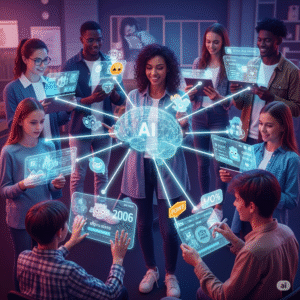The traditional, one-size-fits-all model of education is increasingly becoming a relic of the past. In a rapidly evolving world, the demand for adaptable, engaging, and highly effective learning experiences has never been greater. Enter Artificial Intelligence (AI), a transformative force poised to revolutionize how we learn and teach. The integration of AI in education is not merely about digitizing textbooks or automating administrative tasks; it’s about unlocking the potential for truly personalized learning paths, tailor-made for every individual.
Imagine a classroom where every student receives instruction perfectly aligned with their unique learning style, pace, and existing knowledge. This isn’t a futuristic fantasy; it’s the promise of personalized learning AI. By leveraging vast datasets and sophisticated algorithms, AI can identify individual strengths and weaknesses, recommend specific resources, and adapt teaching methodologies in real-time, creating an educational journey that is profoundly more effective and engaging. This shift is paramount for fostering critical thinking, creativity, and problem-solving skills, preparing students not just for exams, but for life.
The Dawn of Individualized Instruction: Why Traditional Models Fall Short
For centuries, education has largely followed a standardized format. Students move through curricula in cohorts, often at a predetermined pace, with assessment methods that offer a snapshot of understanding rather than a comprehensive picture of growth. While this model has served its purpose, it inherently struggles to cater to the diverse needs of learners. Some students grasp concepts quickly and become disengaged when forced to wait for their peers, while others require more time and varied explanations to truly internalize information.
This disconnect often leads to frustration, disinterest, and, in some cases, students falling behind. Teachers, despite their dedication, are often stretched thin, making it challenging to provide the individualized attention that many students require. This is where the power of AI in education truly shines, offering a scalable solution to these pervasive challenges.
How AI Fuels Personalized Learning AI: The Mechanics of Adaptation
At its core, personalized learning AI operates by collecting and analyzing data on a student’s interactions with learning materials. This includes everything from their performance on quizzes and assignments to the time they spend on specific topics, their preferred learning formats (e.g., video, text, interactive simulations), and even their emotional responses to content (e.g., struggling with a concept, showing quick mastery).
With this rich data, AI algorithms can:
- Identify Knowledge Gaps: Pinpoint specific areas where a student is struggling or has misconceptions.
- Recommend Tailored Content: Suggest articles, videos, exercises, or even entire courses that address those gaps or build upon existing strengths.
- Adjust Pacing: Allow students to accelerate through familiar material or spend more time on challenging concepts without feeling rushed or held back.
- Offer Adaptive Assessments: Provide assessments that adjust in difficulty based on a student’s real-time performance, offering a more accurate measure of understanding.
- Provide Instant Feedback: Deliver immediate, constructive feedback that helps students understand their mistakes and learn from them effectively.
- Suggest Diverse Learning Styles: If a student struggles with visual explanations, the AI might recommend an auditory approach, or vice-versa.
This dynamic feedback loop ensures that the learning experience is continuously optimized for the individual. The impact of AI in education extends beyond academic subjects, as we’ll see with innovative applications like AI for fitness.
Real-World Impact: Transforming Learning Experiences
The theoretical benefits of AI in education are already translating into tangible improvements in various learning environments. From K-12 classrooms to corporate training and lifelong learning initiatives, AI is proving its worth.
One compelling example is DreamBox Learning, a platform that utilizes personalized learning AI for K-8 mathematics. Instead of a fixed curriculum, DreamBox adapts to each student’s progress, offering targeted lessons and activities. If a student struggles with a particular type of problem, the system provides additional practice and different explanations. If they master a concept quickly, they are presented with more advanced challenges. This adaptive approach has been shown to significantly improve student engagement and math proficiency.
Similarly, language learning apps like Duolingo harness AI to create adaptive learning paths. Duolingo’s algorithms analyze user performance, identifying areas of weakness in vocabulary, grammar, or pronunciation. It then tailors subsequent lessons to reinforce those areas, making the learning process highly efficient and personalized.
Case Study: Elevating Corporate Training with AI-Powered Platforms
Let’s consider a practical application in the corporate world. “InnovateCorp,” a global tech company, faced a persistent challenge: ensuring its diverse workforce, spread across different departments and geographical locations, received consistent and effective training on new software updates and compliance regulations. Traditional classroom-based training was costly, time-consuming, and often failed to address individual learning needs, leading to varying levels of skill adoption.
InnovateCorp implemented an AI-powered learning management system (LMS) that integrated modules for various training topics. This platform, powered by advanced personalized learning AI, first assessed each employee’s existing knowledge through pre-assessments and skills gap analyses. Based on this data, the AI generated a customized learning path for each individual. For instance, a software developer might receive deep-dive modules on coding best practices, while a sales representative would focus on customer relationship management (CRM) software updates.
The platform incorporated interactive simulations, gamified challenges, and real-time feedback. AI algorithms continuously monitored employee progress, adjusting the difficulty of tasks and recommending additional resources or remedial modules as needed. The results were striking: InnovateCorp reported a 30% reduction in training time, a 25% increase in employee engagement, and a noticeable improvement in skill adoption across the board. Furthermore, the AI-driven analytics provided leadership with unprecedented insights into skill proficiencies and areas for further development within the workforce, allowing for more strategic resource allocation.
The Role of AI in Business Intelligence and Decision-Making
While AI in education is transforming learning, the underlying principles of AI-driven data analysis are equally impactful in business. Companies are increasingly using AI to sift through vast amounts of data, identify patterns, predict trends, and inform strategic decisions, ultimately driving profit and efficiency. This synergy between data, AI, and insightful action is the essence of modern business intelligence.
Consider a retail giant like “GlobalMart.” Facing intense competition, GlobalMart needed to optimize its inventory management and understand customer purchasing behavior with greater precision. They deployed an AI-powered business intelligence solution. This system ingested data from sales transactions, supply chain logistics, customer feedback, and even social media trends. The AI, using machine learning models, was able to:
- Predict Demand: Accurately forecast demand for specific products based on historical sales, seasonal trends, and even external factors like weather patterns or upcoming holidays. This allowed GlobalMart to optimize inventory levels, reducing waste and preventing stockouts.
- Personalize Marketing: Analyze individual customer purchasing history and Browse behavior to generate highly personalized product recommendations and marketing offers, leading to increased sales conversions.
- Optimize Pricing: Suggest dynamic pricing strategies based on real-time demand, competitor pricing, and inventory levels.
This AI-driven approach transformed GlobalMart’s operations, leading to significant cost savings, increased customer satisfaction, and a stronger competitive edge. The ability of AI in education to personalize learning mirrors the ability of AI in business to personalize customer experiences and operational strategies.
Emerging AI Tools for Business and Education
The market is burgeoning with powerful AI tools that facilitate data analysis and personalized experiences, both in business and education. Here are a few notable examples:
- Tableau: (https://www.tableau.com/) A leading data visualization tool that allows users to create interactive dashboards and reports. While not strictly an AI tool itself, Tableau is increasingly integrating AI and machine learning capabilities to help users discover deeper insights from their data with features like “Ask Data” (natural language queries) and predictive modeling. It’s a cornerstone for turning raw data into actionable insights for businesses.
- ChatGPT (by OpenAI): (https://chat.openai.com/) A powerful language model capable of generating human-like text, answering questions, and even engaging in creative writing. In education, ChatGPT can serve as a personalized tutor, providing explanations, answering student queries, and even generating practice questions. In business, it assists with content creation, customer service (via chatbots), and summarizing vast amounts of information. OpenAI is actively developing versions for education, such as ChatGPT Edu.
- MonkeyLearn: (https://monkeylearn.com/) An AI-powered text analysis platform that helps businesses extract insights from unstructured text data, such as customer reviews, support tickets, and social media mentions. It can perform sentiment analysis, keyword extraction, and topic classification, providing valuable business intelligence to understand customer perceptions and market trends.
- Microsoft Power BI: (https://powerbi.microsoft.com/) Another robust business intelligence tool that enables users to connect to various data sources, create interactive reports, and share insights. Power BI integrates seamlessly with other Microsoft products and offers AI-driven features like “Quick Insights” and natural language Q&A, making data analysis accessible to a wider audience.
These tools exemplify how AI is democratizing data analysis and personalization, making sophisticated capabilities available to organizations of all sizes.
Beginner-Friendly Tips for Implementing AI-Powered Data Analysis
For businesses or educational institutions looking to embark on their AI journey, here are some beginner-friendly tips and workflows:
- Define Your Problem Clearly: Before diving into tools, clearly articulate what problem you want to solve or what insights you seek. Do you want to improve student retention, optimize marketing spend, or personalize employee training? A clear objective will guide your AI implementation.
- Start Small with Accessible Data: Begin with a manageable dataset and a focused use case. Don’t try to solve all your data challenges at once. For example, analyze customer feedback from a single product line or student performance data from one course.
- Leverage User-Friendly AI Tools: Start with tools that have intuitive interfaces and strong community support. Tableau and Power BI are excellent for visualization and initial analysis. For text analysis, MonkeyLearn offers an accessible entry point.
- Focus on Clean Data: AI models are only as good as the data they’re trained on. Ensure your data is clean, accurate, and consistently formatted. This might involve some initial data preparation work.
- Seek Online Resources and Communities: Platforms like HubSpot and Zapier offer valuable resources, tutorials, and communities for learning about AI applications in various fields. For example, HubSpot Academy offers an “AI for Marketers” course.
- Experiment and Iterate: AI implementation is an iterative process. Don’t expect perfect results immediately. Experiment with different models, parameters, and data sources. Learn from your results and refine your approach.
- Consider Ethical Implications: As you implement AI, be mindful of data privacy, bias in algorithms, and transparency. Ensure your AI applications are used responsibly and ethically.
Wellness Redefined: AI Applications for Personalized Fitness and Nutrition
Beyond the Classroom: AI for Fitness and Lifelong Learning
The concept of personalized learning isn’t confined to formal educational settings. The same principles of personalized learning AI are being applied in areas like AI for fitness. Fitness apps now leverage AI to create personalized workout plans based on an individual’s goals, current fitness level, available equipment, and even their progress over time. These apps can adjust repetitions, sets, and exercises, providing real-time feedback on form and suggesting modifications to prevent injury or maximize results. This demonstrates the broad applicability of AI in tailoring experiences to individual needs, whether it’s for academic growth or physical well-being.
The future of education, driven by AI in education, is a future where learning is continuous, adaptive, and deeply personal. It’s a future where every individual has access to a learning path designed to help them reach their full potential, both academically and professionally. As AI continues to evolve, its integration into our learning ecosystems will only deepen, ushering in an era of unprecedented educational efficiency and effectiveness.



